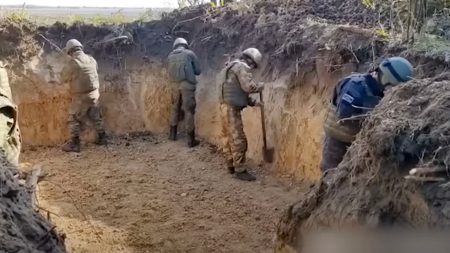The unexpected downfall of Bashar al-Assad, orchestrated by the rebel leader Abu Mohammed al-Jolani, marks a significant turning point in the protracted Syrian civil war. Al-Jolani, also known as Ahmed Al Sharaa, leads Hayat Tahrir al-Sham (HTS), the dominant force behind the swift offensive that ousted Assad. His background is steeped in jihadist ideology, having fought with al-Qaeda in Iraq after the 2003 US invasion and later establishing al-Qaeda’s Syrian affiliate. Despite his past affiliations with extremist groups, al-Jolani has attempted to rebrand HTS as a more moderate entity, distancing itself from its anti-Western roots and presenting a more pragmatic image to the West.
Al-Jolani’s rise to prominence within the Syrian conflict began following the 9/11 attacks, which sparked his interest in jihadist thought. His time in Iraqi prisons further solidified his commitment, leading him to join ISIS until 2012. Returning to Syria with a small group and financial backing, he established al-Qaeda’s presence in the country. Over time, HTS evolved, culminating in its current form in 2016. While the US designated HTS as a terrorist organization and placed a bounty on al-Jolani’s head, the group actively sought to shed its extremist image. This involved purging al-Qaeda and ISIS elements from its ranks, adopting a less overtly religious appearance, and portraying itself as a potential ally against Iran.
The rapid collapse of Assad’s regime highlights HTS’s strategic and organizational prowess. Al-Jolani attributes their success to a “unification of internal opinion,” the establishment of robust institutional structures, and military reforms that instilled discipline and cohesiveness within their ranks. These changes transformed the rebel forces from a disorganized entity into a formidable fighting force capable of swiftly overwhelming Assad’s army. Al-Jolani’s public statements emphasize a commitment to a “free, democratic, and pluralistic Syria,” seeking to reassure civilians, including religious and ethnic minorities, about their safety under HTS rule.
The political landscape of a post-Assad Syria remains uncertain, with various religious and ideological factions vying for power. While HTS has declared its intention to transfer power to a transitional governing body, the practical implementation of this commitment remains to be seen. Al-Jolani’s past, coupled with HTS’s history, raises questions about the group’s true intentions and the future trajectory of the country. The international community will be closely watching developments in Syria, particularly given the potential for continued instability and the rise of new power dynamics in the region.
The swift downfall of Assad’s regime, after a brutal and protracted civil war that spanned over a decade, is a dramatic shift in the region’s geopolitical landscape. The conflict’s trajectory, marked by initial protests, escalating violence, the rise of extremist groups, and international intervention, has left Syria deeply scarred. The involvement of various regional and global powers, including Russia, the United States, Turkey, and Iran, further complicated the situation. The fall of Assad underscores the unpredictable nature of the conflict and the potential for unforeseen consequences.
The transition of power, marked by the Prime Minister’s meeting with rebel leaders, signifies the beginning of a new chapter in Syria’s history. While HTS’s victory declaration emphasizes democratic ideals, the practical realization of these principles remains a significant challenge. The international community, wary of HTS’s past and the potential for further instability, will be closely monitoring the situation. The future of Syria hangs in the balance, with the potential for both positive transformation and continued conflict. The complex interplay of internal and external factors will shape the country’s path, determining whether it can emerge from the ashes of war and build a stable and inclusive future.











